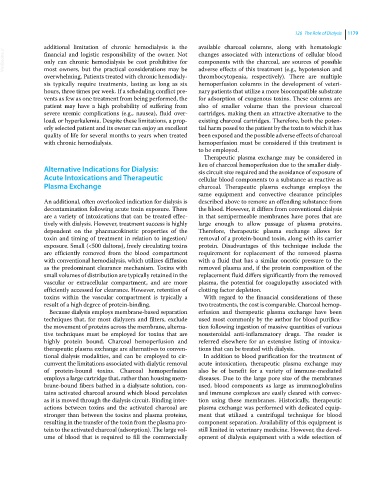Page 1241 - Clinical Small Animal Internal Medicine
P. 1241
126 The Role of Dialysis 1179
additional limitation of chronic hemodialysis is the available charcoal columns, along with hematologic
VetBooks.ir financial and logistic responsibility of the owner. Not changes associated with interactions of cellular blood
components with the charcoal, are sources of possible
only can chronic hemodialysis be cost prohibitive for
most owners, but the practical considerations may be
thrombocytopenia, respectively). There are multiple
overwhelming. Patients treated with chronic hemodialy- adverse effects of this treatment (e.g., hypotension and
sis typically require treatments, lasting as long as six hemoperfusion columns in the development of veteri-
hours, three times per week. If a scheduling conflict pre- nary patients that utilize a more biocompatible substrate
vents as few as one treatment from being performed, the for adsorption of exogenous toxins. These columns are
patient may have a high probability of suffering from also of smaller volume than the previous charcoal
severe uremic complications (e.g., nausea), fluid over- cartridges, making them an attractive alternative to the
load, or hyperkalemia. Despite these limitations, a prop- existing charcoal cartridges. Therefore, both the poten-
erly selected patient and its owner can enjoy an excellent tial harm posed to the patient by the toxin to which it has
quality of life for several months to years when treated been exposed and the possible adverse effects of charcoal
with chronic hemodialysis. hemoperfusion must be considered if this treatment is
to be employed.
Therapeutic plasma exchange may be considered in
lieu of charcoal hemoperfusion due to the smaller dialy-
Alternative Indications for Dialysis: sis circuit size required and the avoidance of exposure of
Acute Intoxications and Therapeutic cellular blood components to a substance as reactive as
Plasma Exchange charcoal. Therapeutic plasma exchange employs the
same equipment and convective clearance principles
An additional, often overlooked indication for dialysis is described above to remove an offending substance from
decontamination following acute toxin exposure. There the blood. However, it differs from conventional dialysis
are a variety of intoxications that can be treated effec- in that semipermeable membranes have pores that are
tively with dialysis. However, treatment success is highly large enough to allow passage of plasma proteins.
dependent on the pharmacokinetic properties of the Therefore, therapeutic plasma exchange allows for
toxin and timing of treatment in relation to ingestion/ removal of a protein‐bound toxin, along with its carrier
exposure. Small (<500 daltons), freely circulating toxins protein. Disadvantages of this technique include the
are efficiently removed from the blood compartment requirement for replacement of the removed plasma
with conventional hemodialysis, which utilizes diffusion with a fluid that has a similar oncotic pressure to the
as the predominant clearance mechanism. Toxins with removed plasma and, if the protein composition of the
small volumes of distribution are typically retained in the replacement fluid differs significantly from the removed
vascular or extracellular compartment, and are more plasma, the potential for coagulopathy associated with
efficiently accessed for clearance. However, retention of clotting factor depletion.
toxins within the vascular compartment is typically a With regard to the financial considerations of these
result of a high degree of protein‐binding. two treatments, the cost is comparable. Charcoal hemop-
Because dialysis employs membrane‐based separation erfusion and therapeutic plasma exchange have been
techniques that, for most dialyzers and filters, exclude used most commonly by the author for blood purifica-
the movement of proteins across the membrane, alterna- tion following ingestion of massive quantities of various
tive techniques must be employed for toxins that are nonsteroidal anti-inflammatory drugs. The reader is
highly protein bound. Charcoal hemoperfusion and referred elsewhere for an extensive listing of intoxica-
therapeutic plasma exchange are alternatives to conven- tions that can be treated with dialysis.
tional dialysis modalities, and can be employed to cir- In addition to blood purification for the treatment of
cumvent the limitations associated with dialytic removal acute intoxication, therapeutic plasma exchange may
of protein‐bound toxins. Charcoal hemoperfusion also be of benefit for a variety of immune‐mediated
employs a large cartridge that, rather than housing mem- diseases. Due to the large pore size of the membranes
brane‐bound fibers bathed in a dialysate solution, con- used, blood components as large as immunoglobulins
tains activated charcoal around which blood percolates and immune complexes are easily cleared with convec-
as it is moved through the dialysis circuit. Binding inter- tion using these membranes. Historically, therapeutic
actions between toxins and the activated charcoal are plasma exchange was performed with dedicated equip-
stronger than between the toxins and plasma proteins, ment that utilized a centrifugal technique for blood
resulting in the transfer of the toxin from the plasma pro- component separation. Availability of this equipment is
tein to the activated charcoal (adsorption). The large vol- still limited in veterinary medicine. However, the devel-
ume of blood that is required to fill the commercially opment of dialysis equipment with a wide selection of

